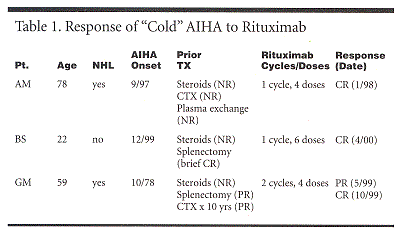Rituximab Can Produce Durable Complete Remissions in Refractory Autoimmune Hemolytic Anemia
BALTIMORE-The B-cell directed monoclonal antibody rituximab (Rituxan) can produce durable complete remissions without the need for maintenance therapy in patients with cold agglutinin autoimmune hemolytic anemia (AIHA) and might also represent a treatment option in warm agglutinin AIHA, according to Edward Lee, MD. Dr. Lee is director of hematology and medical oncology at Sinai Hospital in Baltimore, and Director of the Bone Marrow Transplantation Program.
BALTIMOREThe B-cell directed monoclonal antibody rituximab (Rituxan) can produce durable complete remissions without the need for maintenance therapy in patients with cold agglutinin autoimmune hemolytic anemia (AIHA) and might also represent a treatment option in warm agglutinin AIHA, according to Edward Lee, MD. Dr. Lee is director of hematology and medical oncology at Sinai Hospital in Baltimore, and Director of the Bone Marrow Transplantation Program.
"Autoimmune hemolytic anemia can be a difficult disease to treat," he explained. "When warm or IgG mediated AIHA occurs, response to steroids and/or to splenectomy may well be favorable and lasting, but some patients do not respond durably or may have comorbid conditions that increase the risk of splenectomy. Patients with cold or IgM-mediated AIHA respond poorly to most therapeutic interventions and there is no standard effective treatment for this disease. Both forms are mediated by an antibody, so it seemed reasonable to use selective anti-B-cell agents for refractory AIHA."
Five of the six AIHA patients in a pilot study were female. The age range was 22-83, with a median of 64 years. Three patients had low-grade lymphomas (2 cold, 1 warm) that were identified during the course of treatment and follow-up for AIHA. All patients had prior steroid therapy for AIHA and had disease ranging from 3 months to 20 years.
The three patients with cold agglutinin disease had chemotherapy (2 patients), splenectomy (2 patients), or plasmapheresis (1 patient). The three patients with warm AIHA had no other therapies before rituximab. Those with warm AIHA were steroid dependent at time of treatment with rituximab, and two of the three cold AIHA patients were resistant to all previous treatment before being treated with rituximab.
Patients were given four weekly doses of rituximab (375 mg/m2). No unusual toxicity or complications occurred, according to Dr. Lee.
Five Complete Responses
Five of the six patients had complete hematologic responses following rituximab. This included all three patients with cold AIHA. (See Table 1.) Responses were also observed in patients with warm AIHA. (See Table 2.) Complete response was defined as an increase of hemoglobin and hematocrit into the normal range.

One patient required a second course of treatment, and one was given six doses of rituximab because response was definite but not complete at the end of the planned four doses. This patient had a complete response after six doses.

Duration of response ranged between 4 months and 2.7 years at the time of this report. "One patient required a second treatment after 5 months and has continued in response for an additional 10 months subsequently," Dr. Lee said. No other patients have had recurrent hemolysis.
The investigators concluded that response can be durable without the need for maintenance or other treatments and can occur independently of whether concurrent non-Hodgkin’s lymphoma is present. Patients with longstanding disease (20 years after diagnosis) responded, as did patients with or without NHL.
"Rituximab represents an alternative for both warm and cold AIHA," Dr. Lee stated. "The quality of response in patients presented here suggests that rituximab might be reasonable initial therapy for cold agglutinin disease in that no other interventions are consistently effective. The roll of rituximab in warm AIHA remains to be determined. Rituximab is arguably preferable to long-term corticosteroid use and should be considered early in the course of the disease."
Newsletter
Stay up to date on recent advances in the multidisciplinary approach to cancer.
Elevating the Quality of Cancer Care via Cross-Department Collaboration
Experts from Sibley Memorial Hospital discuss how multidisciplinary work has enhanced outcomes such as survival and resource use at their institution.